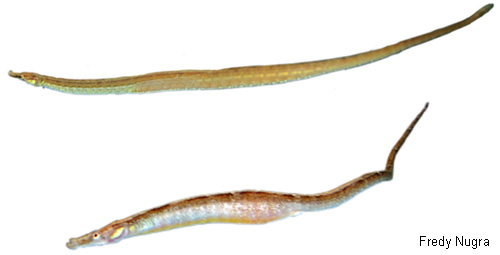Sygnathidae - Pseudophallus starksii (Jordan and Cuvier, 1895) |
 |
| ***Pictures of female and male taken at Rio Pula, Los Rios Province*** |
| SOURCE FOR OCCURRENCE IN ECUADOR: This species occurs along the western slope of southern Ecuador. There are many references for its occurrence in the area (e.g., Barriga, 1989; Barriga, 1991; Barriga, 1994; Bussing, 1998; Laaz & Torres, 2010). |
| ORIGINAL DESCRIPTION: Jordan, D.S. 1895. The fishes of Sinaloa. Proceedings of the California Academy of Sciences (Series 2) 5:377-514, Pls. 26-55. [Also reprinted as Contrib. Biol. Hopkins Seaside Lab. No. 1: 377-514, Pls. 26-55 in which publication date of September 7, 1895 was given in a prefatory note. Signature date of 15 August 1895 but not publication date.] |
| TYPE SPECIMENS: |
| TAXONOMIC STATUS: Valid (Eschmeyer and Fricke, 2012). |
| RANGE ECUADOR: Coastal rivers. |
| RANGE OUTSIDE OF ECUADOR: Pacific coastal rivers from the Gulf of California to Ecuador (Eschmeyer and Fricke, 2012). |
| COLLECTIONS IN ECUADOR: |
| MAXIMUM SIZE: 15.5 cm total length (Bussing, 1998). |
| DISTINGUISHING FEATURES: Pseudophallus starksii is a pipefish and is highly divergent in morphology from most other species in the area. It can be distinguished by the following characters: very elongate body covered in bony rings, small mouth, short snout, 37-44 dorsal fin rays, dark stripes along the snout and behind the eyes (Bussing, 1998).
|
| ECOLOGY: Pseudophallus starksii is known in Ecuador as the “caballito”. It is a small, carnivorous pipefish that feeds primarily on insect larvae and small shrimp (Bussing, 1998). It can be found in streams with bottoms composed of pebbles, as well as shallow streams with slow currents (Barriga, 1989).
|
| ECONOMIC IMPORTANCE: Not economically important because of its small size. |
| CONSERVATION STATUS: NA. |
| LINK TO FISHBASE PAGE: Click here for link |
| SPECIES PROFILE CREATED BY: Enrique Laaz |
| SPECIES PROFILE CONTRIBUTORS: Fredy Nugra, Windsor Aguirre |
|
|
|
|
|
